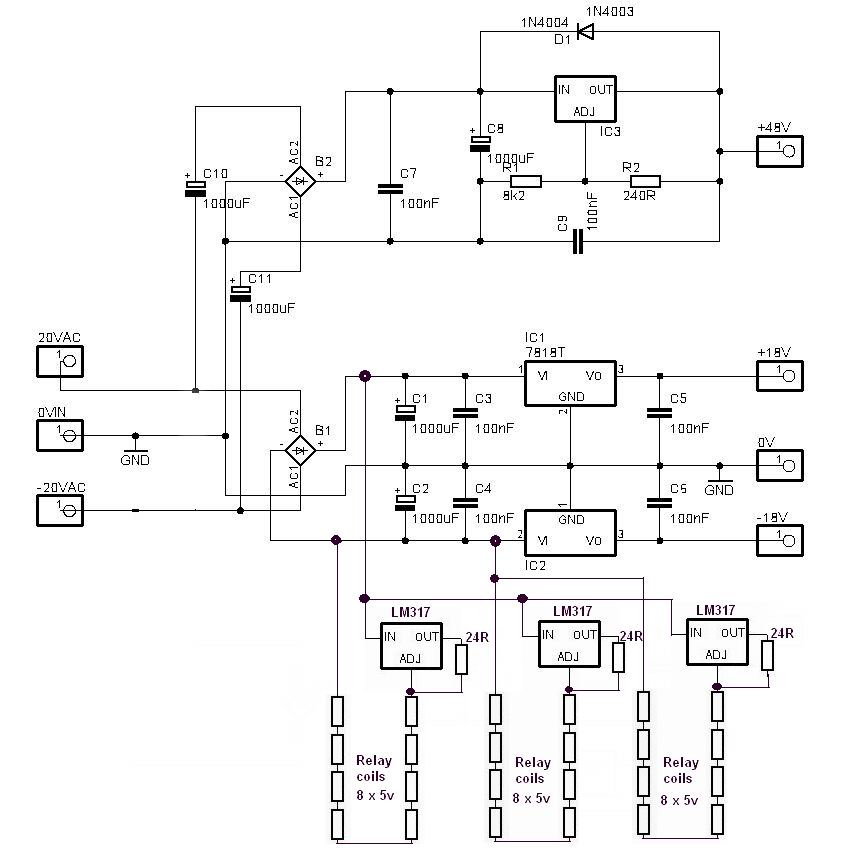> your recifier setup for the 7805s.. the negative side of your bridge is floating on your schematic. did you mean to leave it like that?
Odd but perfectly OK. The lowest-parts answer is: use two plain rectifiers instead of half a bridge rectifier. But actually it is less wiring and about the same price or cheaper to buy a 10-bag of bridges and use half-a-bridge for unipolar outputs.
> I know that Audio and logic power should be kept apart, but surely they can come from the same transformer outputs. Aren't they 'separate' once they are independantly regulated?
No, for reasons Svart explained well. The "regulators" reference a "ground" that has thundering ground-spikes in it.
> I would have thought that as long as the transformer can handle the power throughput, it'd be okay.
That transformer has to be rated for the highest voltage in the system, say 56V (+/-18V after regulation) and the sum of all the currents. Your +/-18V supply is maybe 400mA? And your +5V is 2A, or 1A per side. AC current will be about twice DC current. So you need 40 VAC and 2 Amps AC, an 80VA core. Only 24.5 Watts does useful work (opamps or relays). There is an AWFUL lot of waste heat.
Powering 5V 2A from 20VAC, you have a raw DC supply of 20VAC*1.414= 28V. 5V ends up in logic and relays, 28V-5V= 23V in the regulator. 23V*2A= 46 Watts of wasted heat in the 5V regulator!
From a thermal point of view, the 5V regulator needs a heatsink like from a 100 Watt amplifier.
Economically, that 46 Watts of waste heat costs about a penny an hour on the electric bill. True, if you rent the studio for $100/hr this is small potatoes. But as a personal toy, it costs about $1/month to run, so in a year or two its electric-cost would pay-off the price of a 12VAC CT 2A 24VA transformer, which would waste a lot less power (5V is always wasteful), eat less, and need less regulator heatsinking. And also float the logic ground so it isn't dumping through the analog ground.
(If you are lucky, you can find some surplus tranny with 40VCT plus 12VCT windings, which will work.)
> If I drive my relays with http://focus.ti.com/lit/ds/symlink/sn754410.pdf then i can feed it some basic +5V and feed the relays with a far higher voltage at a lower current.
What are you, a chip-salesman???? (Oh, that's right, you are.....)
That chip is way overkill. I'd do it with one transistor, one resistor, and one diode. Some younger guys will tell you to use a MOSFET, no resistor, maybe no diode. And there are chips to combine all this at maybe less cost/work than discrete solutions.
Use the 2001-2003 chips. They are probably older than you are, and I had some run-around figuring out what prefixes are used now: ULN2001 ULQ2003 DS2003 But here's one you can get from TI: http://www-s.ti.com/sc/ds/ulq2003a.pdf "high-voltage, high-current Darlington transistor arrays. Each consists of seven npn Darlington pairs that feature high-voltage outputs with common-cathode clamp diodes for switching inductive loads. The collector-current rating of a single Darlington pair is 500 mA."
You may not need 7 drivers in one place, but the price is only a buck each (a lot less if you hunt surplus: 2003s have been made and surplused by the millions for over 30 years). That sn754410 costs a whopping $2, and has a lot of frivolous functions and pins to defeat or strap.
> Sound nuts?
Yes, we are.





































